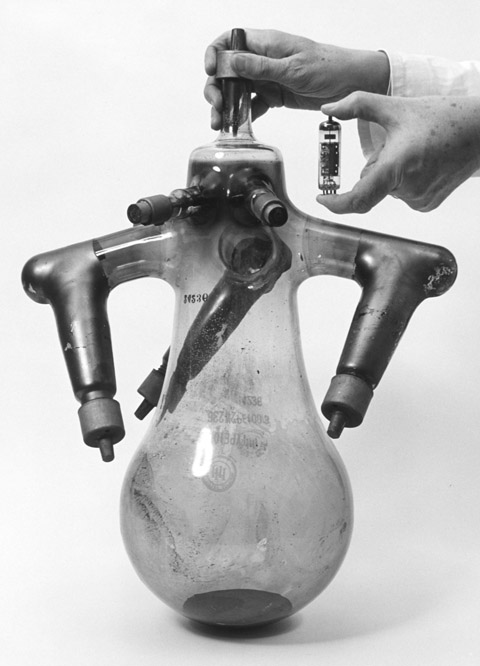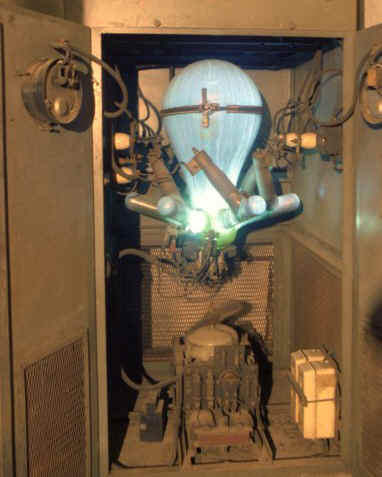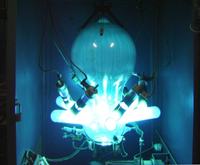A mercury mercury rectifier (also called a Hewitt rectifier) is an electrical rectifier used to convert alternating current into direct current. These rectifiers were used in all applications requiring high power, from several kilowatts to several megawatts. Operating voltages ranged from 110V to 30kV. Their method of operation is based on the discovery that the electric arc between the mercury pool and the metal electrode allows current to flow in one direction. They usually had several anodes powered by a multiphase transformer, where the electric arc jumped from the cathode (mercury pool) to individual anodes. This allowed for more precise and continuous operation of the rectifier. Six-phase and even twelve-phase systems were often used using star-connected three-phase transformers with phase-to-phase transformers at the connections.

These devices were used in many areas of life. Primarily, they were used to power electric motors in industry, electric railway lines, trams and electric locomotives. They were also used in electrical stations and as rectifiers for transmitting high-voltage direct current.

The structure is based on a glass bulb, as seen in the photos, cooled by an external fan or copper pipes running around the bulb through which water is pumped. In higher power rectifiers, capable of handling currents of approximately 500 amperes, passive cooling in the form of a steel container is used.

In order for the rectifier to work, it must be "started" first, i.e. the creation of an electric arc between the mercury pool and the electrodes. An igniter is used for this purpose, usually consisting of an electrode that can be immersed in the mercury using an external electromagnet. The igniter produces a small spark to ionize the mercury vapor, which then ignites the main electric arc between the anode and cathode.
Excerpt from the story Jake Purches: “I was talking about mercury rectifiers with my neighbor who is an electrical engineer who is now 85 years old. One of his tasks at work was installing rectifiers. He explained to me why they were delivered upside down, each with about a liter of mercury inside. He said the trick was to twist the rectifier very carefully so that the mercury flowed to the base of the bulb and not into the extensor arms. If mercury were to get into one of the extensor arms, the arm would break under the weight, causing the extensor to shoot out the mercury it contained in all directions, which sometimes happened. This job was intended only for experienced workers. The rectifiers were delivered in boxes in which they hung on a special hammock to avoid shocks during transport. The light they emitted while working was very bright, and one can also guess that its spectrum contained very strong UV radiation.”
Nowadays, mercury rectifiers are no longer used in industry. They have been completely replaced by cheaper, more efficient and smaller semiconductor rectifiers.
Source :
http://www.electricstuff.co.uk/mercarc.html
http://forums.atomicmpc.com.au/index.php?showtopic=14715&st=0

These devices were used in many areas of life. Primarily, they were used to power electric motors in industry, electric railway lines, trams and electric locomotives. They were also used in electrical stations and as rectifiers for transmitting high-voltage direct current.

The structure is based on a glass bulb, as seen in the photos, cooled by an external fan or copper pipes running around the bulb through which water is pumped. In higher power rectifiers, capable of handling currents of approximately 500 amperes, passive cooling in the form of a steel container is used.

In order for the rectifier to work, it must be "started" first, i.e. the creation of an electric arc between the mercury pool and the electrodes. An igniter is used for this purpose, usually consisting of an electrode that can be immersed in the mercury using an external electromagnet. The igniter produces a small spark to ionize the mercury vapor, which then ignites the main electric arc between the anode and cathode.
Excerpt from the story Jake Purches: “I was talking about mercury rectifiers with my neighbor who is an electrical engineer who is now 85 years old. One of his tasks at work was installing rectifiers. He explained to me why they were delivered upside down, each with about a liter of mercury inside. He said the trick was to twist the rectifier very carefully so that the mercury flowed to the base of the bulb and not into the extensor arms. If mercury were to get into one of the extensor arms, the arm would break under the weight, causing the extensor to shoot out the mercury it contained in all directions, which sometimes happened. This job was intended only for experienced workers. The rectifiers were delivered in boxes in which they hung on a special hammock to avoid shocks during transport. The light they emitted while working was very bright, and one can also guess that its spectrum contained very strong UV radiation.”
Nowadays, mercury rectifiers are no longer used in industry. They have been completely replaced by cheaper, more efficient and smaller semiconductor rectifiers.
Source :
http://www.electricstuff.co.uk/mercarc.html
http://forums.atomicmpc.com.au/index.php?showtopic=14715&st=0
Cool? Ranking DIY



